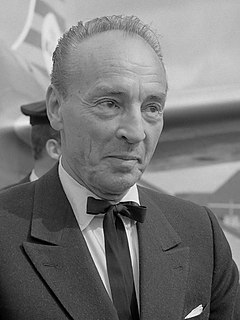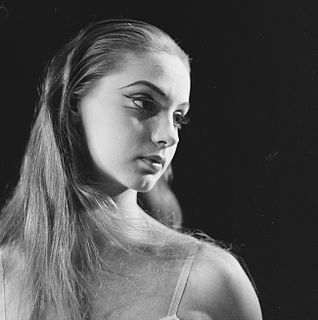
George Balanchine was a Georgian-American ballet choreographer who was one of the most influential 20th-century choreographers. Styled as the father of American ballet, he co-founded the New York City Ballet and remained its Artistic Director for more than 35 years. His choreography is characterized by plotless ballets with minimal costume and décor, performed to classical and neoclassical music.

The John F. Kennedy Center for the Performing Arts is the United States National Cultural Center, located on the Potomac River in Washington, D.C. It was named in 1964 as a memorial to assassinated President John F. Kennedy. Opened on September 8, 1971, the center hosts many different genres of performance art, such as theater, dance, orchestras, jazz, pop, psychedelic, and folk music.

New York City Ballet (NYCB) is a ballet company founded in 1948 by choreographer George Balanchine and Lincoln Kirstein. Balanchine and Jerome Robbins are considered the founding choreographers of the company. Léon Barzin was the company's first music director. City Ballet grew out of earlier troupes: the Producing Company of the School of American Ballet, 1934; the American Ballet, 1935, and Ballet Caravan, 1936, which merged into American Ballet Caravan, 1941; and directly from the Ballet Society, 1946.

Suzanne Farrell is an American ballerina and the founder of the Suzanne Farrell Ballet at the Kennedy Center in Washington, D.C.

Violette Verdy was a French ballerina, choreographer, teacher, and writer who worked as a dance company director with the Paris Opera Ballet in France and the Boston Ballet in the United States. From 1958 to 1977 she was a principal dancer with the New York City Ballet where she performed in the world premieres of several works created specifically for her by choreographers George Balanchine and Jerome Robbins. She was Distinguished Professor of Music (Ballet) at the Jacobs School of Music, Indiana University, in Bloomington, and the recipient of two medals from the French government.
Jewels is a three-act ballet created for the New York City Ballet by co-founder and founding choreographer George Balanchine. It premièred on Thursday, 13 April 1967 at the New York State Theater, with sets designed by Peter Harvey and lighting by Ronald Bates.

Apollo is a neoclassical ballet in two tableaux composed between 1927 and 1928 by Igor Stravinsky. It was choreographed in 1928 by twenty-four-year-old George Balanchine, with the composer contributing the libretto. The scenery and costumes were designed by André Bauchant, with new costumes by Coco Chanel in 1929. The scenery was executed by Alexander Shervashidze, with costumes under the direction of Mme. A. Youkine. The American patron of the arts Elizabeth Sprague Coolidge had commissioned the ballet in 1927 for a festival of contemporary music to be held the following year at the Library of Congress in Washington, D.C.

Stars and Stripes is a neoclassical ballet choreographed by George Balanchine to music by John Philip Sousa, orchestrated by Hershy Kay. The ballet was made as a tribute to the United States, Balanchine's adopted country. It premiered on January 17, 1958, at the City Center of Music and Drama, danced by the New York City Ballet. It is dedicated to Fiorello La Guardia, former mayor of New York City. The ballet had been revived by multiple ballet companies, and at different special occasions.

Nicholas Magallanes was a principal dancer and charter member of the New York City Ballet. Along with Francisco Moncion, Maria Tallchief, and Tanaquil Le Clercq, Magallanes was among the core group of dancers with which George Balanchine and Lincoln Kirstein formed Ballet Society, the immediate predecessor of the New York City Ballet.
Sarah Van Patten is an American ballet dancer. She began an apprenticeship at the Royal Danish Ballet at age 15. In 2001, at age 17, she became the youngest ever dancer to receive a contract at the company. Later that year, she joined the San Francisco Ballet as a soloist, and was promoted to principal dancer in 2007. She is set to retire from performing in 2022.
Mozartiana is a ballet choreographed by George Balanchine to Tchaikovsky's Orchestral Suite No. 4, Mozartiana. The current version of the ballet was made for New York City Ballet's Tchaikovsky Festival, and premiered on June 4, 1981, at the New York State Theater. It is considered Balanchine's last major work.
Élégie is a neoclassical ballet by George Balanchine, to Élégie-Elegy for solo viola by Igor Stravinsky. Balanchine had made three versions of the ballet, premiered in 1948, 1966 and 1982 respectively.
Chaconne is a ballet made by New York City Ballet co-founder and ballet master George Balanchine to ballet music from Gluck's Orfeo ed Euridice. The premiere took place Wednesday, 22 January 1976 at the New York State Theater, Lincoln Center, with lighting by Ronald Bates; Robert Irving conducted. Chaconne was danced in practice clothes at its premiere; Karinska's costumes were added in the spring season.

Who Cares? is a ballet choreographed by George Balanchine to songs by George Gershwin that were orchestrated by Hershy Kay. The ballet is split in two parts, the first danced by an ensemble, and the second focuses on four principal dancers. Who Cares? premiered on February 5, 1970, at the New York State Theater, danced by the New York City Ballet.
Natalia Magnicaballi is a principal ballet dancer with the Suzanne Farrell Ballet and Ballet Arizona.

The Sarasota Ballet is an American ballet company based in Sarasota, Florida. It was founded in 1987 by former ballet dancer Jean Weidner Goldstein and is now acclaimed for its performances of Sir Frederick Ashton's ballets under its director Iain Webb and assistant director Margaret Barbieri.
Danielle Brown is an American ballet dancer. She joined Florida's Sarasota Ballet in 2007 where she is now a principal dancer.
Movements for Piano and Orchestra is a neoclassical ballet choreographed by George Balanchine to Stravinsky's score of the same name. The ballet premiered on April 9, 1963, at City Center of Music and Drama, performed by the New York City Ballet. Though the two lead roles were created for Diana Adams and Jacques d'Amboise, seventeen-year-old Suzanne Farrell danced the female lead at the premiere due to Adams' pregnancy. Starting in 1966, Movements and Monumentum pro Gesualdo (1960) are performed together.
Duo Concertant is a ballet choreographed by George Balanchine to Stravinsky's score of the same name. The ballet was created for New York City Ballet's Stravinsky Festival, a tribute to the composer a year after his death, and premiered on June 22, 1972, at the New York State Theater, danced by Kay Mazzo and Peter Martins.
Divertimento No. 15 is a ballet choreographed by George Balanchine to Mozart's eponymous music. The ballet was made for the New York City Ballet. Balanchine first choreographed the score in 1952, for a ballet titled Caracole. In 1956, he planned to revive Caracole for a celebration of Mozart's bicentenary but made a new ballet to the same music instead. Divertimento No. 15 premiered on May 31, 1956, at the American Shakespeare Theatre, Stratford, Connecticut.









